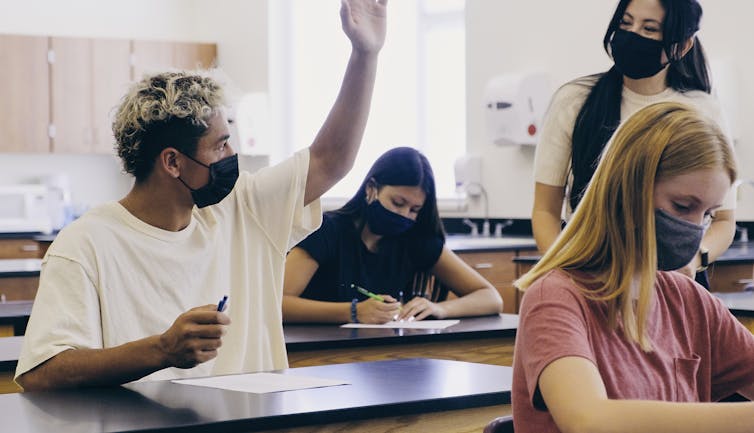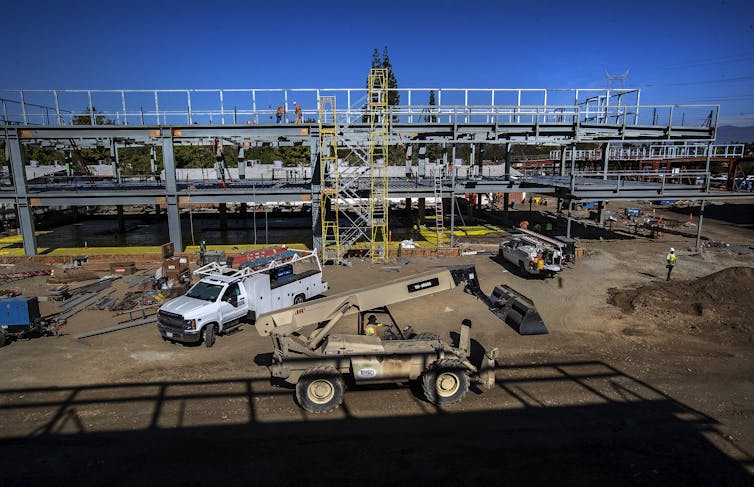Wind farms bring windfalls for rural schools, but school finance laws limit how money is spent
- Written by Eric Brunner, Professor of Economics and Policy, University of Connecticut
On the website for the local school district in Blackwell – a town of just over 300 people in rural Texas – school Superintendent Abe Gott says: “We believe that no matter your dreams, you can achieve them from Blackwell, Texas.[1]”
To back that up, the Blackwell Consolidated Independent School District provides a postsecondary scholarship of up to US$36,000[2] for graduates from the district’s single high school. So far 140 students have benefited from scholarships, according to Gott.
The money that makes this possible came from a $35 million deal the school district brokered with a wind farm company in 2005, part of the massive growth of that sector[3] in Nolan County and Texas.
The spread of wind energy in rural America has been a financial boon to school districts such as the one in Blackwell. However, because of the complexity of how schools are financed, the impact on student achievement is limited[4], according to a new study that we conducted as researchers in public finance[5], education economics[6] and energy policy[7].
Windfall of wind taxes
Nolan County – one of three counties served by the school district – is home to 1,371 wind turbines[8] that generate a maximum of 2,097 megawatts, or enough to power half a million Texas homes per year. That includes the 585-megawatt Sweetwater Wind Farm[9] and the 735-megawatt Horse Hollow project[10], which was the largest in the world when it came online in 2006.
Over the past 25 years wind energy has blossomed in the United States, rising from less than 2 gigawatts of capacity in 1995 to over 110 GW last year[11], enough to meet more than 7% of the entire nation’s electricity supply. It provides more than 10% of supply in 14 states, and more than 40% in two of those states — Iowa and Kansas.
By 2020, there were over 1,600 commercial wind installations made up of almost 68,000 individual turbines[12]. The industry is continuing to grow rapidly, with another 200 gigawatts[13] of projects applying for grid connections as of the end of 2020.
With all this rural development come property tax revenues. Wind projects paid an estimated $1.6 billion in property tax revenues[14] to states and local jurisdictions in 2019.
That is no doubt welcome revenue for school districts in rural areas, which sometimes struggle to generate local tax revenue[15]. But as researchers we wanted to know: How are school districts using wind farm revenues? And is this money helping boost student achievement?
 Revenue from wind turbines can allow for schools to hire more teachers.
RichLegg/E+ via Getty Images[16]
Revenue from wind turbines can allow for schools to hire more teachers.
RichLegg/E+ via Getty Images[16]
To find out, we collected data on new U.S. wind installations from 1995 through 2017 and tax revenue trends in school districts. We then checked to see if new wind farms led to significant changes in school budgets and how school districts spent their money, such as on things like new buildings, hiring more teachers to reduce class sizes, or boosting teacher salaries.
We found that wind energy installations led to large increases in local revenues to school districts[17]. Schools dramatically increased spending on capital outlays, such as buildings and equipment, but made only modest increases to their operating budgets, like hiring more teachers to reduce class size.
When priorities and policies collide
Numerous studies have shown that smaller class sizes result in better student achievement[18]. So why are districts putting new tax revenues into capital spending rather than class size reduction?
We think it is due to state school finance formulas and state- and county-level tax laws, and the incentives they provide to school administrators.
As wind grew it expanded from only 16 school districts in 1995 to 900 districts spread across 38 states[19] in 2016. Leading the pack are rural areas of the West, the Midwest and Texas.
The amount of tax revenue a school district gets from a wind energy installation depends on state and local laws and how those laws interact with state school finance formulas.
States use a wide variety of approaches to tax wind farms, ranging from normal property tax treatment to full exemptions. Sometimes wind farms make “payments in lieu of taxes,” known as PILOTs.
Kansas, for example, exempts wind projects from property taxes for the first 10 years. Some wind companies make PILOT payments to hosting counties, but individual school districts are often left out of those deals. Wyoming has a centralized system of school finance, so any revenue generated from wind projects is captured entirely by the state and redistributed to schools following a formula.
Texas, the No. 1 wind energy state[20], has a complicated system of local taxation of wind farms. Because of the state’s school finance system, much of the additional property tax revenue generated by wind installations can be captured by the state.
Texas uses a formula to take money from school districts with high property tax revenues per pupil and give it to poorer districts.
But that does not apply to local property tax revenue dedicated to paying off debt in Texas. So school districts have a strong incentive to borrow money by selling bonds to pay for capital improvements, then use revenues from the wind farms to pay off the bonds.
As a result, school districts in Texas tend to put wind tax revenues into buildings and facilities, rather than into teachers and operations. For example, the Blackwell school district, in addition to its scholarship fund, has spent $15 million for a new football stadium and academic complex.
Impact on school finances
The growth in wind energy development over time and across the country provides an ideal setting to examine how wind energy – or really any outside boost in funding – can impact school district finances and, in turn, student performance.
Our sample included 638 school districts that had a wind energy installation at some point between 1995 and 2017. Not surprisingly, these “wind districts” tend to be smaller and more rural than the average school district.
We found that new wind farms result in large increases in the amount of local revenue that is brought in per student, with only small reductions in state aid. We also found large boosts in per-pupil expenditures. Texas, especially, collected and spent more than other states.
But we found that most of those new expenditures were used for building improvements or new facilities rather than operating or “current” expenses. District spending on buildings went up by as much as 73%, while operating expenditures increased only slightly, by about 2%.
 Schools are more likely to use new wind revenues to build up their infrastructure.
Mel Melcon/Los Angeles Times via Getty Images[21]
Schools are more likely to use new wind revenues to build up their infrastructure.
Mel Melcon/Los Angeles Times via Getty Images[21]
Formulas at play
This allocation of funds seems to be driven in part by the formulas that states use to provide aid to local school districts. States typically reduce the amount of funds they send to a district that sees an increase in local tax revenues, in order to equalize spending.
In some cases, though, that applies only when a district spends more on day-to-day operations, not when it boosts building improvements or new construction. So to avoid losing state aid, districts are more likely to use any new local revenues from wind farms for new buildings or repairs than for operating expenses.
This is exactly what we saw in our study. While school facilities and equipment no doubt improved, new wind farm revenues resulted in little to no change in class sizes or teacher salaries. In line with past research that shows better lower student-to-teacher ratios are clearly connected to student achievement[22], we found little change in student outcomes.
So while new development from wind energy can significantly boost rural economies and tax revenues, decisions on how the money is used are still made within the constraints of local school finance policy and law.
[Get our best science, health and technology stories. Sign up for The Conversation’s science newsletter[23].]
References
- ^ We believe that no matter your dreams, you can achieve them from Blackwell, Texas. (www.blackwellhornets.org)
- ^ postsecondary scholarship of up to US$36,000 (www.blackwellhornets.org)
- ^ massive growth of that sector (www.citizen.org)
- ^ the impact on student achievement is limited (emp.lbl.gov)
- ^ public finance (scholar.google.com)
- ^ education economics (scholar.google.com)
- ^ energy policy (scholar.google.com)
- ^ 1,371 wind turbines (eerscmap.usgs.gov)
- ^ Sweetwater Wind Farm (www.duke-energy.com)
- ^ Horse Hollow project (en.wikipedia.org)
- ^ over 110 GW last year (emp.lbl.gov)
- ^ 68,000 individual turbines (www.sciencebase.gov)
- ^ another 200 gigawatts (emp.lbl.gov)
- ^ $1.6 billion in property tax revenues (cleanpower.org)
- ^ struggle to generate local tax revenue (ednote.ecs.org)
- ^ RichLegg/E+ via Getty Images (www.gettyimages.com)
- ^ wind energy installations led to large increases in local revenues to school districts (emp.lbl.gov)
- ^ better student achievement (theconversation.com)
- ^ spread across 38 states (eta-publications.lbl.gov)
- ^ No. 1 wind energy state (emp.lbl.gov)
- ^ Mel Melcon/Los Angeles Times via Getty Images (www.gettyimages.com)
- ^ clearly connected to student achievement (theconversation.com)
- ^ Sign up for The Conversation’s science newsletter (theconversation.com)
Authors: Eric Brunner, Professor of Economics and Policy, University of Connecticut


